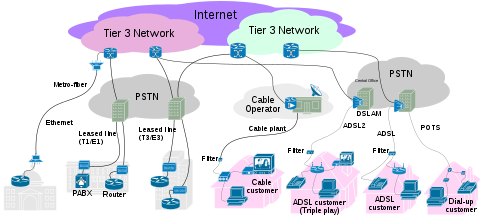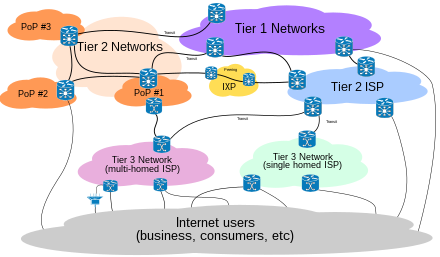Internet service provider
From Wikipedia, the free encyclopedia
"ISP" redirects here. For other uses, see ISP (disambiguation).
|
|
This article needs additional citations for verification. (June 2007) |
| Internet |
|---|

An Opte Project visualization of routing
paths through a portion of the Internet. |
| General |
| Governance |
| Protocols · Infrastructure |
|
| Services |
| Guides |
Internet service providers can be either community-owned and non-profit, or privately owned and for-profit.
Access ISPs directly connect clients to the Internet using copper wires, wireless or fiber-optic connections.[1] Hosting ISPs lease server space for smaller businesses and other people (colocation). Transit ISPs provide large amounts of bandwidth for connecting hosting ISPs to access ISPs.[2]
Contents |
History
The Internet started off as a closed network between government research laboratories and relevant parts of universities. As it became more popular, universities and colleges started giving more of their members access to it. As a result of its popularity, commercial Internet service providers sprang up to offer access to the Internet to anyone willing to pay for the service, mainly to those who missed their university accounts. In 1990, Brookline, Massachusetts-based The World became the first commercial ISP.[3]Classification
Access providers
Main article: Internet access
ISPs employ a range of technologies to enable consumers to connect to their network.[citation needed]If users and small businesses, traditional options include: dial-up, DSL (typically Asymmetric Digital Subscriber Line, ADSL), broadband wireless, cable modem, fiber to the premises (FTTH), and Integrated Services Digital Network (ISDN) (typically basic rate interface).[citation needed]
For customers with more demanding requirements, such as medium-to-large businesses, or other ISPs, DSL (often Single-Pair High-speed Digital Subscriber Line or ADSL), Ethernet, Metropolitan Ethernet, Gigabit Ethernet, Frame Relay, ISDN (B.R.I. or P.R.I.), ATM (Asynchronous Transfer Mode) and upload satellite Internet access. Sync-optical cabling (SONET) is more likely to be used.[citation needed]
Many access providers also provide hosting and email services.[citation needed]
Mailbox Providers
A Mailbox Provider is a department or organization that provides email mailbox hosting services. Not to be confused with Email service provider. Many Mailbox Providers are also Access Providers,[4] but there is no overlapping between those two roles. The definition given in RFC 6650 further characterizes Mailbox Providers as organizations that accept, store, and offer access to email messages for end users. That definition covers email hosting services, as well as (the relevant department of) companies, universities, organizations, groups, and individuals that manage their mail servers themselves. The task is typically accomplished by implementing Simple Mail Transfer Protocol (SMTP) and possibly providing access to messages through Internet Message Access Protocol (IMAP), the Post Office Protocol, Webmail, or a proprietary protocol.[5]Hosting ISPs
Hosting ISPs routinely provide email, FTP, and web-hosting services. Other services include virtual machines, clouds, or entire physical servers where customers can run their own custom software.[citation needed]Transit ISPs
Just as their customers pay them for Internet access, ISPs themselves pay upstream ISPs for Internet access. An upstream ISP usually has a larger network than the contracting ISP and/or is able to provide the contracting ISP with access to parts of the Internet the contracting ISP by itself has no access to.[6]In the simplest case, a single connection is established to an upstream ISP and is used to transmit data to or from areas of the Internet beyond the home network; this mode of interconnection is often cascaded multiple times until reaching a Tier 1 carrier. In reality, the situation is often more complex. ISPs with more than one point of presence (PoP) may have separate connections to an upstream ISP at multiple PoPs, or they may be customers of multiple upstream ISPs and may have connections to each one of them at one or more point of presence.[7]
Virtual ISPs
Main article: Virtual ISP
A Virtual ISP (VISP) is an operation which purchases services from another ISP (sometimes called a "wholesale ISP" in this context)[8]
which allow the VISP's customers to access the Internet using services
and infrastructure owned and operated by the wholesale ISP.Free ISPs
Free ISPs are Internet Service Providers (ISPs) which provide service free of charge. Many free ISPs display advertisements while the user is connected; like commercial television, in a sense they are selling the users' attention to the advertiser. Other free ISPs, often called freenets, are run on a nonprofit basis, usually with volunteer staff.[citation needed]Peering
Main article: Peering
ISPs may engage in peering, where multiple ISPs interconnect at peering points or Internet exchange points
(IXs), allowing routing of data between each network, without charging
one another for the data transmitted—data that would otherwise have
passed through a third upstream ISP, incurring charges from the upstream
ISP.[9]ISPs requiring no upstream and having only customers (end customers and/or peer ISPs) are called Tier 1 ISPs.[citation needed]
Network hardware, software and specifications, as well as the expertise of network management personnel are important in ensuring that data follows the most efficient route, and upstream connections work reliably. A tradeoff between cost and efficiency is possible.[citation needed]
Law enforcement/intelligence assistance
Internet service providers in many countries are legally required (e.g. CALEA in the U.S.) to allow law enforcement and intelligence agencies to monitor some or all of the information transmitted by the ISP. Modern ISPs integrate a wide array of surveillance and packet sniffing equipment into their networks, which then feeds the data to law-enforcement/intelligence networks and software such as DCSNet in the United States, or SORM in Russia, allowing them to monitor Internet traffic in real time.[citation needed]See also
- Broadband Internet access
- Broadband wireless access
- Cable Internet
- Communications Assistance for Law Enforcement Act
- Dial-up
- DSL
- Federation of Internet Solution Providers of the Americas (FISPA)
- Free-net
- IP address
- Internet backbone
- Internet Provider Security
- ISDN
- Leased line
- Modem
- Network access point
- Second-level ISP
- Wireless internet service provider
- Category:Internet service providers
External Resources
References
|
|
This article needs additional citations for verification. (June 2007) |
- ^ thefoa.org/tech/fo-or-cu.htm - The Fiber Optic Association Copper and Fiber as data medium
- ^ cisco.com Sample Configuration for BGP with Two Different Service Providers (Multihoming) BGP article
- ^ Robert H'obbes' Zakon. "Hobbes' Internet Timeline v10.1". Retrieved November 14, 2011. Also published as Robert H. Zakon
- ^ J.D. Falk, ed. (November 2011). Complaint Feedback Loop Operational Recommendations. IETF. RFC 6449. Retrieved 28 June 2012.
- ^ Murray Kucherawy, ed. (June 2012). Creation and Use of Email Feedback Reports: An Applicability Statement for the Abuse Reporting Format (ARF). IETF. RFC 6650. Retrieved 28 June 2012.
- ^ Gerson & Ryan A Primer on Internet Exchange Points for Policymakers and Non-Engineers Working Paper, August 11, 2012
- ^ Id.
- ^ Amazing.com "Hooking up to the Internet"
- ^ Gerson & Ryan A Primer on Internet Exchange Points for Policymakers and Non-Engineers Working Paper, August 11, 2012


Tidak ada komentar:
Posting Komentar